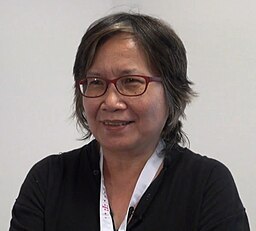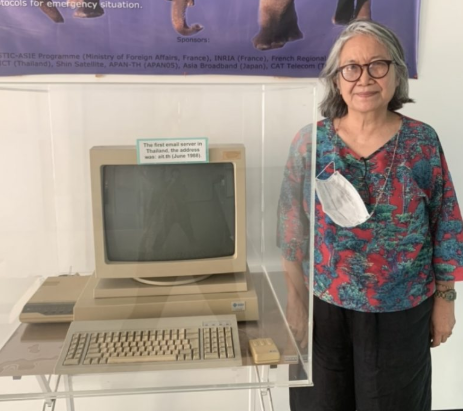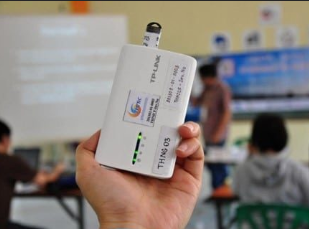Pioneers
7. Networks
7.2. Kanchana Kanchanasut

Figure 1: Kanchana Kanchanasut.
Source: Imaginingtheinternet (2013)
Downloadable teaching resource
Overview
Dr. Kanchana Kanchanasut (กาญจนา กาญจนาสุต) is a pioneer for the internet in Thailand, laying the foundations and working to improve access to the internet with community network projects.
Background
Born in the Tak Province, Thailand, into a family of 11, Dr. Kanchanasut first attended the University of Queensland on a scholarship to complete a B.Sc. in Mathematics in 1974, as well as a Graduate Diploma in Computer Science in the same year. Following this, in 1979 she attended the University of Melbourne to complete her M.Sc. followed by her Ph.D. in 1991, both again in Computer Science (AIT, 2022; Stanton, 2017).
Contributions
Dr Kanchanasut is primarily known for her work as the first Thai individual to use email in 1986, having co-created a computer network to establish connection to universities in Tokyo and Melbourne, and registering and managing the .th country code domain (Suriyasarn, 2002).
 Figure 2: Professor Kanchana Kanchanasut beside the first email server in Thailand (AIT, 2021)
Figure 2: Professor Kanchana Kanchanasut beside the first email server in Thailand (AIT, 2021)
During her time as a professor for the Asian Institute of Technology (AIT), she focused on advancing wireless technologies throughout Southeast Asia, citing the violent weather patterns common to the area and having seen how wireless technology can help organise aid and communications during natural disasters (Internet Hall of Fame, 2013).
Dr Kanchanasut currently works as the Chairperson for the AIT Internal International Education and Research Laboratory (IntERLab) Steering Committee, as well as a research professor for the same organisation (ESCAP, 2024). Through intERLab, some projects have included working on training and education for disaster relief and use of networking to assist, education and research around IoT Sensors for air quality in relation to open burning and forest fires, as well as establishing TakNet to support the connection of rural villages to the internet (intERLab, 2024).
Feature: TakNet Community Network Project
Within Thailand in 2017, there was a push for fibre optic networks via the One Access Per Village project, looking to connect 24,700 villages via a public access Wi-Fi point per village. However this hotspot is not necessarily close to the people who need it, which can present difficulties, especially for young students or children (Bidwell and Jenson, 2019). TakNet took a different approach, directly connecting people from the province of Tak, with routers in their own home, allowing households to pay a small monthly fee (two to three times cheaper than commercial broadband) for access including technical support from local trained technicians and maintenance.
The initial idea for TakNet was a wireless mesh network that could be easily transformed for the purposes of emergency communications during potential disasters, an idea that was furthered with Digital Ubiquitous Mobile Broadband OSLR (DUMBO) firmware installed on the small mobile routers. TakNet, as reported in 2021, has grown to connect around 500 houses in 30 villages (Apikul, 2021), with a continued emphasis on communities gaining the skills required to be able to run the network themselves (Kanchanasut et al., 2018; Sathiaseelan, 2017).

Figure 3: DUMBONET mobile router. Source: AIT (2021)
Watch
An interview between Kanchana Kanchanasut and the Imaging the Internet Center discussing Kanchana's work (and challenges) bringing the internet to Thailand and her hopes and fears for the future.
Video 1: IETF and Internet Hall of Fame 2013: Kanchana Kanchanasut (Imagining the Digital Future Center, 2013)
Transcript
I was lucky to be part of the people who spread the Internet through Southeast Asia. I brought the Internet to Thailand. That was the reason why I've been recognized.
That was more than 25 years ago. So at that time nobody knew about the Internet. Even to use the existing telephone for email - that type of technology was totally new. So introducing technology to a country which was not aware of the possibility was not easy. It was very tough to do, and once people started to know about this new technology the existing telecommunications operators were afraid of the impact on their business. So, we had to, all the time, try to live with that - under that condition, which is not easy. That was the challenging part of our task - to be able to introduce the technology to the public and at the same time we needed to be able to work out with the telecommunications operator that we had to look for the benefit of the whole country, instead of looking at their business alone.
I always see the Internet as sunny. There's so many exciting things that happened over the past 20, almost 30 years for me. It's always sunny. Even though there are many challenging problems, a lot of issues that you never looked at before. Once you have Internet technology coming in, you start to ask yourself and try to quantify to yourself the impact of the Internet, which makes you understand your society even better. So I always view this with a positive point of view, and I think it's always sunny.
As it is sunny, I don't fear anything. I like the sun. Whatever technology you bring in there's always a negative side of that. If you start fearing that negative aspect, which prevents you from doing any other interesting things, I think you are not going on the right track. I think the best way is try to understand the new technology and its impact and how we can try to accommodate that in our society and make sure more people will benefit more from the technology than the negative impact. Greatest hope is that I want the Internet to be - I would like everybody to be able to access the Internet as cheapest - as a basic infrastructure for all. With that kind of society you find that many of the problems in our society today should not happen - like corruption in government - because things would be more open to the public and people would find it harder to do things that they used to do in the past. I think that is the positive aspect of an open society that the Internet brought.
Right now as you can see there are many organizations that try to address the issue of the Internet and society, like the Internet Governance Forum the resources of the Internet by the organizations like ICANN and so on. We should encourage people to participate in this kind of process. These types of organizations are new. The multistakeholder model is new and it is something that we should try to make work. Once it works, I think it's a good channel where everybody can try to get the best out of the technology for the majority because in the multistakeholder everybody can get involved in decisions.
At the moment, I'm just a normal professor in computer science and I lead a research group that concentrates on networking in post-disaster environments. This type of activity is trying to provide answers to the more frequent natural disasters that are occurring in our region at the moment. That is my role. The future of the Internet for me is - I could not say anything specific - I see the Internet as always sunny. So for me, the future of the Internet is still sunny. If the multistakeholder model works well, I think we are on the right path.
References and further reading
Apikul, C. (2021) Dr. Kanchana Kanchanasut: On Connecting with Communities. Available at: https://www.internetsociety.org/blog/2021/06/dr-kanchana-kanchanasut-on-connecting-with-communities (Accessed 13 July 2025)
Asian Institute of Technology (AIT) (2021) IntERLab ‘DUMBONET’ 15 years of service from disaster-hit to rural communities. Available at: https://oldweb.ait.ac.th/2021/06/interlab-dumbonet-15-years-of-service-from-disaster-hit-to-rural-communities/ (Accessed: 19 August 2025).
Asian Institute of Technology (AIT) (2022) Kanchana Kanchanasut. Available at: https://web.archive.org/web/20220929183848/https://set.ait.ac.th/faculty/kanchana-kanchanasut (Accessed 06 May 2025)
Bidwell, N. and Jensen, M. (2019) Bottom-Up Connectivity Strategies: Community-led small-scale telecommunication infrastructure in the global South. Available at: https://www.apc.org/sites/default/files/bottom-up-connectivity-strategies_0.pdf (Accessed 13 July 2025)
Economic and Social Commission for Asia and the Pacific (ESCAP) (2024) Kanchana Kanchanasut. Available at: https://www.unescap.org/node/39545 (Accessed 06 May 2025)
Imaginingtheinternet (2013) File:Kanchana Kanchanasut - 2013.jpg. Available at: https://commons.wikimedia.org/wiki/File:Kanchana_Kanchanasut_-_2013.jpg (Accessed 06 May 2025)
Imagining the Digital Future Center (2013) IETF and Internet Hall of Fame 2013: Kanchana Kanchanasut. Available at: https://www.youtube.com/watch?v=A3ag1RnPj_4 (Accessed: 13 July 2025)
IntERLab (2024) intERLab Updates: Research on IoT, PM2.5 and Forest Fire. Available at: https://apstar.asia/retreat/2024/bangkok/Session%20I%20-%205%20interlab_AP_2024.pdf (Accessed 06 May 2025)
Internet Hall of Fame (2013) Using Mobile Technology to Help Folks Survive Cyclones, Tsunamis and Political Disasters. Available at: https://www.internethalloffame.org/2013/10/21/using-mobile-technology-help-folks-survive-cyclones-tsunamis-and-political-disasters (Accessed 06 May 2025)
Kanchanasut, K. interviewed by the Internet Hall of Fame (2013) Professor Beats Daunting Odds, Upheaval to Link Thailand to Internet. Available at: https://www.internethalloffame.org/2013/10/21/professor-beats-daunting-odds-upheaval-link-thailand-internet (Accessed 06 May 2025)
Kanchanasut, K., Lertsinsubtavee, A., Tunpan, A., Tansakul, N., Mekbungwan, P., Weshsuwannarugs, N. and Tripatana, P. (2018) Building Last-meter Community Networks in Thailand. Available at: https://giswatch.org/sites/default/files/gw2018_thailand_0.pdf (Accessed 13 July 2025)
Sathiaseelan, A. (2017) TakNet — Community networking in Thailand. Available at: https://blog.apnic.net/2017/02/17/taknet-community-networking-thailand (Accessed 13 July 2025)
Stanton, K. (2017) Homecomings: The Educator: Kanchana Kanchanasut. Available at: https://blogs.unimelb.edu.au/3010/homecomings-the-educator (Accessed 06 May 2025)
Suriyasarn, B. (2002) Analysis of Thai Internet and Telecommunications Policy Formation During the Period 1992-2000. Available at: http://rave.ohiolink.edu/etdc/view?acc_num=ohiou1020103463 (Accessed 06 May 2025)